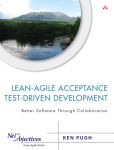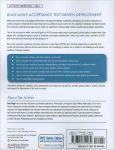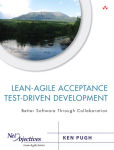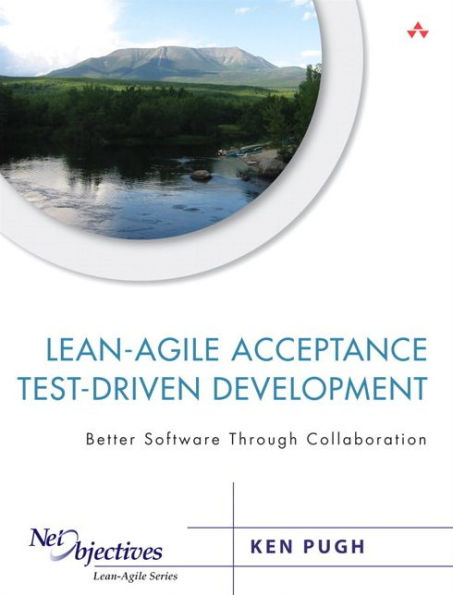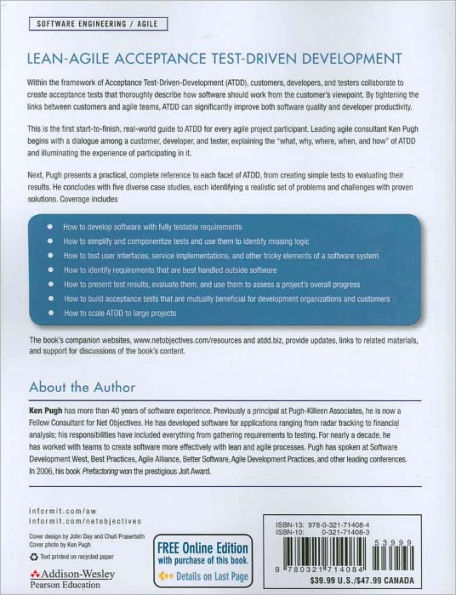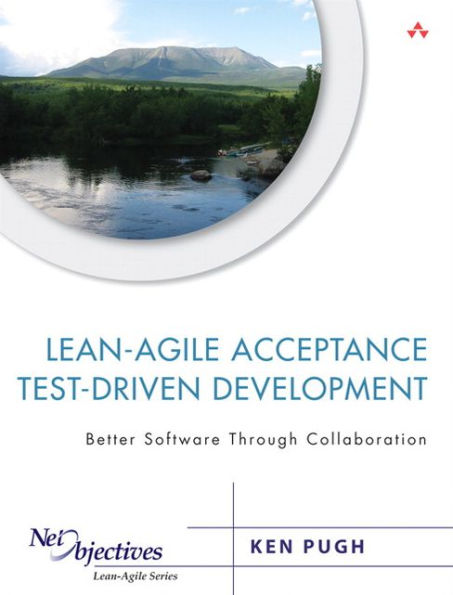Lean-Agile Acceptance Test-Driven Development: Better Software Through Collaboration / Edition 1 available in Paperback, eBook

Lean-Agile Acceptance Test-Driven Development: Better Software Through Collaboration / Edition 1
- ISBN-10:
- 0321714083
- ISBN-13:
- 9780321714084
- Pub. Date:
- 01/05/2011
- Publisher:
- Pearson Education
- ISBN-10:
- 0321714083
- ISBN-13:
- 9780321714084
- Pub. Date:
- 01/05/2011
- Publisher:
- Pearson Education

Lean-Agile Acceptance Test-Driven Development: Better Software Through Collaboration / Edition 1
Buy New
$44.99Buy Used
$25.05
-
SHIP THIS ITEM— This item is available online through Marketplace sellers.
-
PICK UP IN STORE
Your local store may have stock of this item.
Available within 2 business hours
This item is available online through Marketplace sellers.
-
SHIP THIS ITEM
Temporarily Out of Stock Online
Please check back later for updated availability.
Overview
Praise for Lean-Agile Acceptance Test-Driven Development
“Lean-Agile Acceptance Test-Driven Development tells a tale about three fictive project stakeholders as they use agile techniques to plan and execute their project. The format works well for the book; this book is easy to read, easy to understand, and easy to apply.”
—Johannes Brodwall, Chief Scientist, Steria Norway
“Agile development, some say, is all about pairing, and, yes, I’m a believer in the power of pairing. After reading this book, however, I became a fan of the ‘triad’—the customer or business analyst + the developer + the tester, who work collaboratively on acceptance tests to drive software development. I’ve written some patterns for customer interaction and some patterns for testing and I like what Ken Pugh has chosen to share with his readers in this down-to-earth, easy-to-read book. It’s a book full of stories, real case studies, and his own good experience. Wisdom worth reading!”
—Linda Rising, Coauthor of Fearless Change: Patterns for Introducing New Ideas
“The Agile Manifesto, Extreme Programming, User Stories, and Test-Driven Development have enabled tremendous gains in software development; however, they’re not enough. The question now becomes ‘How can I ensure clear requirements, correct implementation, complete test coverage, and more importantly, customer satisfaction and acceptance?’ The missing link is acceptance as defined by the customer in their own domain language. Lean-Agile Acceptance Test-Driven Development is the answer.”
—Bob Bogetti, Lead Systems Designer, Baxter Healthcare
“Ken Pugh’s Lean-Agile Acceptance Test-Driven Development shows you how to integrate essential requirements thinking, user acceptance tests and sounds, and lean-agile practices, so you can deliver product requirements correctly and efficiently. Ken’s book shows you how table-driven specification, intertwined with requirements modeling, drives out acceptance criteria. Lean-Agile Acceptance Test-Driven Development is an essential guide for lean-agile team members to define clear, unambiguous requirements while also validating needs with acceptance tests.”
—Ellen Gottesdiener, EBG Consulting, www.ebgconsulting.com, Author of Requirements by Collaboration and The Software Requirements Memory Jogger
“If you are serious about giving Agile Testing a chance and only have time to read one book, read this one.”
—David Vydra, http://testdriven.com
“This book provides clear, straightforward guidance on how to use business-facing tests to drive software development. I’m excited about the excellent information in this book. It’s a great combination of the author’s experiences, references to other experts and research, and an example project that covers
many angles of ATDD. A wide range of readers will learn a lot that they can put to use, whether they work on projects that call themselves lean or agile or simply want to deliver the best possible software product.”
—Lisa Crispin, Agile Tester, ePlan Services, Inc., Author of Agile Testing
Within the framework of Acceptance Test-Driven-Development (ATDD), customers, developers, and testers collaborate to create acceptance tests that thoroughly describe how software should work from the customer’s viewpoint. By tightening the links between customers and agile teams, ATDD can significantly improve both software quality and developer productivity.
This is the first start-to-finish, real-world guide to ATDD for every agile project participant. Leading agile consultant Ken Pugh begins with a dialogue among a customer, developer, and tester, explaining the “what, why, where, when, and how” of ATDD and illuminating the experience of participating in it.
Next, Pugh presents a practical, complete reference to each facet of ATDD, from creating simple tests to evaluating their results. He concludes with five diverse case studies, each identifying a realistic set of problems and challenges with proven solutions.
Coverage includes
• How to develop software with fully testable requirements
• How to simplify and componentize tests and use them to identify missing logic
• How to test user interfaces, service implementations, and other tricky elements of a software system
• How to identify requirements that are best handled outside software
• How to present test results, evaluate them, and use them to assess a project’s overall progress
• How to build acceptance tests that are mutually beneficial for development organizations and customers
• How to scale ATDD to large projects

Product Details
| ISBN-13: | 9780321714084 |
|---|---|
| Publisher: | Pearson Education |
| Publication date: | 01/05/2011 |
| Series: | Net Objectives Lean-Agile Series |
| Pages: | 368 |
| Product dimensions: | 6.80(w) x 9.10(h) x 1.00(d) |
About the Author
Kenneth Pugh has over two-fifths of a century of software experience. Previously a principal at Pugh-Killeen Associates, he is now a fellow consultant for Net Objectives. He has developed software applications ranging from radar tracking to financial analysis. Responsibilities have included everything from gathering requirements to testing. After the start of the new millennium, he has worked with teams to create software more effectively with lean and agile processes. He has spoken at numerous national conferences; consulted and taught all over the world; and testified on technology topics. This is his seventh book. In 2006, his book Prefactoring won the Jolt Award [DrDobbs01]. In his spare time, he snowboards, windsurfs, and backpacks. Between 1997 and 2003, he completed the Appalachian Trail. The cover photograph of Mount Katahdin, the northern end of the trail, was taken by the author from Abol Bridge in Maine.
Table of Contents
Introduction 1
Part I: The Tale
Chapter 1: Prologue 9
Ways to Develop Software 9
One Way 9
Another Way 9
The Difference 10
The Importance of Acceptance Tests 10
System and Team Introduction 12
The System 12
The People 13
Summary 14
Chapter 2: Lean and Agile 15
The Triad and Its Units 15
Post-Implementation Tests 17
Quick Feedback Better Than Slow Feedback 18
Preimplementation Tests 19
Lean and Agile Principles 20
Summary 21
Chapter 3: Testing Strategy 23
Types of Tests 23
Where Tests Run 25
Test Facets 26
Control and Observation Points 27
New Test Is a New Requirement 27
Summary 28
Chapter 4: An Introductory Acceptance Test 29
A Sample Business Rule 29
Implementing the Acceptance Tests 31
Test Script 32
Test User Interface 33
xUnit Test 34
Automated Acceptance Test 35
An Overall Test 36
Testing Process 37
Summary 37
Chapter 5: The Example Project 39
The Charter 39
Objectives 40
Project Acceptance Tests 41
High-Level Requirements 43
Features 43
Feature Acceptance Criteria 45
Summary 46
Chapter 6: The User Story Technique 47
Stories 47
Features into Stories 48
Roles 49
Role Attributes 49
Persona 50
Stories for Roles 51
Story Acceptance Criteria 52
Acceptance Tests Determine Size 53
Customer Terms 54
INVEST Criteria 55
Summary 56
Chapter 7: Collaborating on Scenarios 57
Use Cases from User Stories 57
Simple Use Case 59
Exceptions and Alternatives 60
Acceptance Tests 63
Documentation 63
Story Map 63
Conceptual Flow 65
Communication 66
Summary 68
Chapter 8: Test Anatomy 69
Triad Creates Tests 69
Test Context 70
Test Structure 71
Calculation Table 73
Data Table 74
Action Table 75
Tests with Example Values 76
Requirements Revised 77
Acceptance Test Revised 78
Test with Values in Text 79
When and Where Tests Are Run 80
Summary 81
Chapter 9: Scenario Tests 83
Tests for Exception Scenarios 83
Tests for Business Rules 87
Cross-Story Issues 88
Don’t Automate Everything 89
Multi-Level Tests 90
User Interface Tests 93
Check the Objectives 93
Summary 94
Chapter 10: User Story Breakup 95
Acceptance Tests Help Break Up Stories 95
Business Rule Tests 96
A Story with a Business Rule 100
Summary 101
Chapter 11: System Boundary 103
External Interfaces 103
More Details 107
External Interface Tests 108
Component Tests 108
Test Doubles and Mocks 111
What Is Real? 112
Story Map of Activities 113
Summary 114
Chapter 12: Development Review 115
The Rest of the Story 115
Usability Testing 116
Separating State from Display 116
Quality Attribute Tests 118
Workflow Tests 119
Deployment Plans 120
From Charter to Deliverable 120
Summary 121
Part II: Details
Chapter 13: Simplification by Separation 125
Complex Business Rules 125
Simplify by Separating 126
The Simplified Rule 128
Rental History 128
Summary 130
Chapter 14: Separate View from Model 131
Decouple the User Interface 131
Decoupling Simplifies Testing 136
Summary 136
Chapter 15: Events, Responses, and States 137
Events and an Event Table 137
States and State Transitions 139
Internal State or External Response 142
Transient or Persistent States 144
A Zen Question 144
Summary 144
Chapter 16: Developer Acceptance Tests 145
Component Acceptance Tests 145
Field Display Tests 145
Tabular Display Tests 147
Summary 151
Chapter 17: Decouple with Interfaces 153
Tests for a Service Provider 153
The Interface 153
Quality Attribute Tests 155
Comparing Implementations 155
Separating User Interface from Service 157
Separation of Concerns 158
Reusable Business Rules 158
Summary 159
Chapter 18: Entities and Relationships 161
Relationships 161
Entities and Relationships 161
Multiple Relationships 163
Alternative Representations 166
Summary 166
Chapter 19: Triads for Large Systems 167
Large Systems 167
When a Customer Test May Not Be Required 169
Data Conversion 170
Database Conversions 170
What If There Are No Tests? 170
Legacy Systems 172
Summary 173
Part III : General Issues
Chapter 20: Business Capabilities, Rules, and Value 177
Business Capabilities 177
Scenario Handling 178
Business Rules Exposed 179
A Different Business Value 179
Summary 181
Chapter 21: Test Presentation 183
Customer Understood Tables 183
Table Versus Text 185
Specifying Multiple Actions 185
Complex Data 187
Custom Table Forms 188
Summary 189
Chapter 22: Test Evaluation 191
Test Facets 191
Understandable to Customers 191
Spell Checked 192
Idempotent 192
Not Fragile 192
Test Sequence 193
Workflow Tests 193
Test Conditions 194
Separation of Concerns 194
Test Failure 195
Test Redundancy 196
No Implementation Issues 197
Points to Remember 197
Summary 198
Chapter 23: Using Tests for Other Things 199
Uses of Acceptance Tests 199
Degree of Doneness 199
Estimation Aid 200
Breaking Down Stories 200
Developer Stories 200
Tests as a Bug Report 201
Root Cause Analysis 201
Production Bugs 202
Regression Testing 202
Summary 202
Chapter 24: Context and Domain Language 205
Ubiquitous Language 205
Two Domains 207
Summary 208
Chapter 25: Retrospective and Perspective 209
Recap 209
The Process 210
Testing Layers 210
The Tests 211
Communication 212
What’s the Block? 212
Monad 212
Unavailable Customer 213
Change 213
Risks 214
Benefits 214
Summary 215
Part IV Case Studies
Chapter 26: Case Study: Retirement Contributions 219
Context 219
The Main Course Test 220
Setup 220
Event 221
Expected 221
Implementation Issues 222
Separation of Concerns 222
Business Value Tracking 223
One Exception 223
Event 223
Expected 224
Another Exception 225
Event 225
Expected 225
Two Simultaneous Exceptions 226
Event 226
Expected 227
The Big Picture 227
Event Table 228
State Transition Table 228
Summary 230
Chapter 27: Case Study: Signal Processing 231
It’s Too Loud 231
Sound Levels 231
Developer Tests 233
Summary 233
Chapter 28: Case Study: A Library Print Server 235
The Context 235
A Workflow Test 236
Summary 241
Chapter 29: Case Study: Highly Available Platform 243
Context for Switching Servers 243
Test for Switching Servers 244
Test for Technical Rule 246
Summary 248
Part V : Technical Topics
Chapter 30: How Does What You Do Fit with ATDD? 251
Test Platforms 251
Internal Design from Tests 252
Device Testing 254
Starting with User Interfaces 255
Black Box Testing 255
Unit Testing 256
Summary 256
Chapter 31: Test Setup 257
A Common Setup 257
Some Amelioration 259
Test Order 260
Persistent Storage Issues 260
Summary 261
Chapter 32: Case Study: E-Mail Addresses 263
Context 263
Breaking Down Tests 264
Local-Part Validation 265
Domain Tests 266
Disallowed Domain Tests 268
Test to Ensure Connection 269
Verification Test 269
Summary 270
Part VI : Appendices
Appendix A: Other Issues 273
Context 273
Customer Examples 274
Fuzzy Acceptance Tests 274
Acceptance Test Detail 275
Requirements and Acceptance Tests 275
Documenting Requirements and Tests 276
Decoupling Requirements 276
Separation of Issues 276
Testing Systems with Random Events 277
The Power of Three 277
Summary 278
Appendix B: Estimating Business Value 279
Business Value 279
Developer Stories 281
Summary 282
Appendix C: Test Framework Examples 283
The Examples 283
Fit Implementation 284
Setup 284
Check-Out CD 284
Check-In 286
Category-Based Rental Fees 287
Slim–Table Style 288
Header 288
Setup 288
Check-Out CD 288
Check-In 290
Category-Based Rental Fees 291
Slim–Cucumber Style 291
Setup 291
Check-Out CD 292
Check-In CD 292
Scenario Library 292
Category-Based Rental Fees 294
Robot 295
Setup 295
Check-Out CD 295
Check-In CD 296
Category-Based Rental Fees 296
Cucumber 296
Check-Out CD 297
Check-In CD 297
Category-Based Rental Fees 297
Test Frameworks 298
Summary 298
Appendix D: Tables Everywhere 299
User Interface Tests with Tables 299
Requirement Tables 301
Another Table 302
Quality Attribute Requirements 303
Data Tables 304
Summary 304
Appendix E: Money with ATDD 305
The Context 305
The Original Tests 306
The Acceptance Test Approach 307
Summary 310
Appendix F: Exercises 311
Calculator 311
Create Some Tests 313
More Exercises 313
Sam’s CD Rental 314
Triangle 314
File Copying Exercise 314
References 315
Epilogue 323
Index 333
